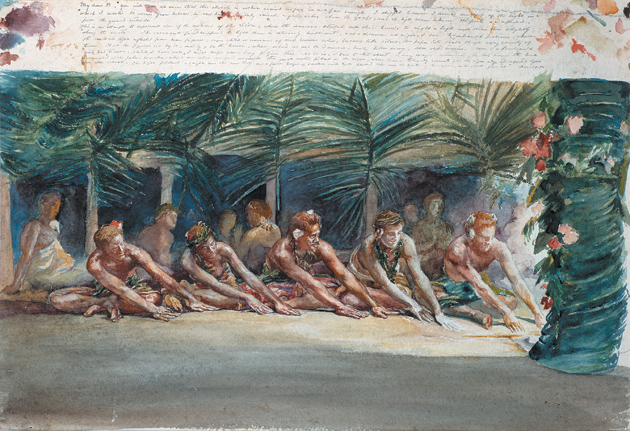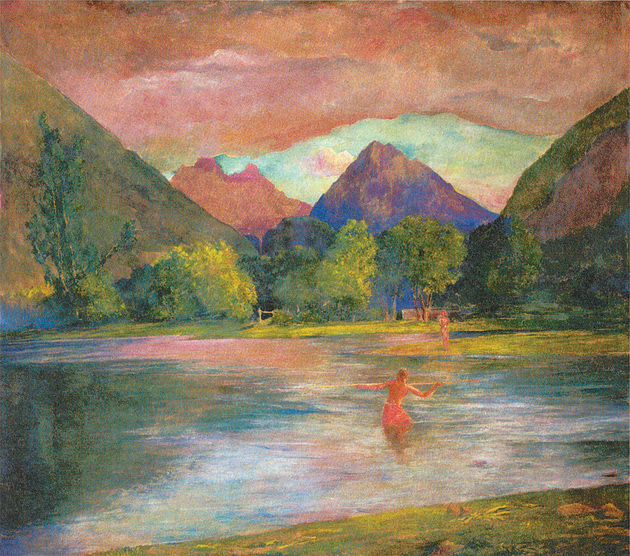At the time of his death in 1910, at the age of seventy-five, John La Farge was among the most revered American artists. Known for his large-scale public murals for courtrooms and state capitols, and for his masterly stained-glass windows in churches and Gilded Age mansions, he could seem to his admirers an American counterpart to the versatile English designer William Morris. Today, a hundred years later, when his work is recognized at all, it is his more intimate paintings that are likely to attract the attention of a visitor at a museum: deft watercolors that register the evanescent effects of seasonal change, or small oil landscapes of rock-strewn pastures, executed in the darker tones of Millet or Corot, that evoke a mood as much as a specific place.
At first, the exhibition of John La Farge’s work in the South Pacific, during a yearlong voyage begun in 1890, gave the impression of fascinating, often beautiful things left unfinished, abandoned, or unresolved. Originally mounted at Yale, and then filling four rooms at the recently renovated Addison Gallery of American Art in Andover, Massachusetts, the exhibition showed tiny sketchbooks with their deft penciled contours and verbal reminders of wave and cloud (“blue reflecting top sky like blue jap silk”), photographs purchased or snapped along the way by La Farge’s traveling companion, the historian Henry Adams, and iridescent watercolor sketches of native rituals performed beneath moonlit palm trees. But the culminating works of art we were led to expect never quite followed from so much painstaking preparatory research and industrious documentation.
No sooner had this first impression coalesced, however, than another, more lasting, supplanted it. Instead of wishing that translucent washes of purple and pink would somehow thicken into Gauguin’s ecstatic walls of color, or that provisional jottings of word and image would move decisively toward a dispassionate ethnographic report, the viewer realized that the tentative and fragmentary works on view were, after all, what La Farge’s elusive art consists of. These are the distinctive expressions of what Adams, who admired above all his friend’s achievement in reviving the medieval art of stained glass, called La Farge’s “opaline” mind, with its “infinite shades and refractions of light, and with color toned down to the finest gradations.”
As soon as one stops trying to force La Farge into some preexisting category—exotic beachcomber in the wake of Melville and Pierre Loti, amateur anthropologist, Gilded Age gentleman-aesthete—one finds oneself in the presence of a distinctively odd and affecting artist. La Farge’s voyages, at a time when the archipelagoes of the South Pacific were destinations only for the wealthiest or most reckless travelers, retain their own fascination. The art that emerged from them, as the contributors to the excellent catalog of the exhibition make clear, still awaits a full understanding.
A leisurely adventure in the Pacific, with a sojourn in Japan, was to have been something of a second honeymoon for Henry Adams and his wife of twenty years, Marian Hooper Adams, during the early months of 1886. Like newlyweds, they were about to move into a striking new house, built along Japanese lines by the architect Henry Hobson Richardson, across Lafayette Square from the White House. From such a vantage point, Adams, the grandson and great-grandson of presidents, and his wife, a gifted photographer known as Clover, would have a privileged view of the Democratic presidency of Grover Cleveland, which Adams, a lifelong Republican, had supported, as though the United States, too, needed a fresh start.
A journey to the East would allow the very rich couple to furnish their house with scrolls and lacquer, for the choice of which they could count on the expertise of the physician-turned-Buddhist and art collector William Sturgis Bigelow, a favorite cousin of Clover’s, who was to be their host in Japan. The splendors and miseries of Pacific travel might also distract Clover from some private griefs, including the death of her father, from which she seemed alarmingly slow to recover. Amid preparations for departure, Adams returned from an errand to find that Clover had drunk a lethal cocktail of potassium cyanide, a chemical used in her photography.
Bereft, and more eager than ever to escape his life in Washington, Adams had the inspired idea of inviting John La Farge to join him on the trip. Broadminded, cosmopolitan, at ease in the world if a little finicky—he reportedly found it unbearable to shake hands—La Farge had come of age in a well-to-do New York family of partly French origin. An inheritance following his father’s death in 1859 allowed him to give up a career in law for art; he had studied with Manet’s teacher, Thomas Couture, in Paris before settling in Newport. Among the first wave of artists in the West to take an interest in Japanese prints, he published a pioneering attempt, in 1869, to identify what was distinctive in Japanese art. He also introduced Japanese motifs into his own work, such as the swooningly gorgeous composition, executed in leaded glass, of an off-center bough of mauve and pink cherry blossoms hanging over a spring freshet of melting snow.
Advertisement
Adams had known La Farge since the early 1870s, when he had briefly taught medieval French history at Harvard. La Farge at the time was in charge of the interior decoration of Richardson’s Trinity Church in Boston, where Adams’s cousin Reverend Phillips Brooks presided. La Farge’s remarkable contributions to Trinity, including murals and stained glass, had given a decisive new direction to his career, leading to lavish public and private commissions. His serendipitous discovery of opalescent glass, made, he claimed, when he saw sunlight refracted through an empty bottle of toothpaste, encouraged people he knew to invest in the La Farge Decorative Art Company in New York.
When Adams approached La Farge, however, he found his old friend’s life in a state of disarray that matched his own. A ruinous lawsuit against his principal rival, Louis Comfort Tiffany, regarding primacy in the invention of opalescent glass, had contributed to the bankruptcy of the La Farge firm. La Farge’s marriage—to a grandniece of Commodore Matthew Perry, the man who “opened” Japan—had all but dissolved, and he had embarked on an affair with an assistant in his studio on Tenth Street in New York. He was struggling with the concept of a large, unfinished mural for the Church of the Ascension on lower Fifth Avenue.
On the Japanese journey, Adams and La Farge saw many things they admired, such as Mount Fuji—which La Farge later added, a little incongruously, to the background of his mural of the ascending Christ—and the forested shrines at Nikko. The overwhelming impression, however, was that they had arrived too late, and that opportunities for collecting were slight. “Japan has been cleaned out,” Adams complained to his friend John Hay. A happier discovery was that they traveled well together, with La Farge offering a cultivated visual sensibility while Adams provided the money—enormous amounts of money—and a more dyspeptic response to Japanese food, geishas, and the tea ceremony.
Restless after the completion of his monumental History of the United States During the Administrations of Thomas Jefferson and James Madison, Adams proposed another journey, this time to remote outposts less overrun with tourists than Japan. “We wished to go very far,” La Farge wrote. “Japan is too near. They have the telegraph there.” The South Pacific, by contrast, “always means two months without news.” Hawaii, where they arrived by steamer in late August 1890, had the amenities of civilization while allowing La Farge a leisurely month to attune his vision to what he called the “chords of colour” of the tropics. The Hawaiian moon, as though posing for a stained-glass window, was “an opaline circle of greenish blue light, with variant iridescent redness in the cloud edges.”
It was only when they reached Samoa, in early October, that they felt they were finally in “the true Polynesia.” “Here are no horse-cars or electric lights,” Adams noted with satisfaction, “and not many clothes.” A visit with Robert Louis Stevenson, who was there in search of relief from tuberculosis, and his American wife struck a discordant note—“a very dirty board cabin,” wrote Adams, “with a still dirtier man and woman in it, in the middle of several hundred burned tree-stumps.” A prettier sight was a view of half-naked Samoan girls sliding down waterfalls, at which “La Farge’s spectacles quivered with emotion.”
What moved them most, however, was the tropical light as it played across the surface of the waves. The two friends became connoisseurs of the so-called “afterglow,” when sky and surf were irradiated by the setting sun. Under La Farge’s tutelage, Adams became “gently intoxicated on the soft violets and strong blues, the masses of purple and the broad bands of orange and green in the sunsets.” La Farge took notes on the pattern of the waves breaking across a coral reef, then made a superb watercolor based on his observations. The best description of such scenes, at once overwhelming and elusive, comes from his own account, in what the art historian John Stuart Gordon, writing in the catalog, aptly calls a “stained-glass window of words”:
There was all the charm that belongs to the near coasting of land in smooth waters: the rise and fall of the great green reflections in the blue satin of the sea inside of the reef; the sharp blue outside of the white line of reef all iridescent with the breaking of the surf; the patches of coral, white or yellow or purple, wavering below the crystal swell, so transparent as to recall the texture of uncut topaz or amethyst; the shoals of brilliant fish, blue and gold-green, as bright and flickering as tropical hummingbirds; the contrast of great shadows upon the mountain, black with an inkiness that I have never seen elsewhere; the fringes of golden or green palms upon the shores, sometimes inviting, sometimes dreary.
Wavelike, too, was the undulating motion La Farge discerned in seated dancers sweeping their arms rhythmically from side to side in the traditional Siva dance. In his watercolor of the scene, palm fronds above the dancers mimic their oscillating gestures. A long explanatory message to the artist’s son Bancel is scrawled across the top margin. It is unclear whether we are looking at an illustrated letter or a picture with commentary, a finished work or a provisional set of notes and sketches put aside for some later, more ambitious undertaking. La Farge’s message includes a puzzling remark: “You will see at once that the sketch is either carried too far, or not far enough.”
Advertisement
The large oil portrait titled Sketch of Maua, Apia. One of our boat crew raises similar questions. The faunlike boy sits with legs crossed, attentive to something off to the side, and unaware of an observer’s presence. Brilliant red hibiscus flowers adorn his hair and bloom in the branches that curve around his bronzed body. His expressive hands and prominent big toe are illuminated by light breaking in from the lushly green foliage. Nothing about the picture suggests incompleteness; there are no unpainted surfaces, as in Cézanne or Degas, nothing blurred or irresolute. Again, however, La Farge has added an inscription, this time directly across the lower expanse of the painted canvas, concluding with the underlined word “unfinished.”
In an interesting essay, the art historian Henry Adams (a distant relative of La Farge’s companion) notes that the canvas, from the Addison Gallery’s collection, was first framed in such a way as to conceal the inscription, but has recently been reframed to reveal it. The inscription, as Adams remarks, describes how the painting was done the day that La Farge and Adams left Samoa, “that the boat was held for him while he completed it, and that he finally left the painting incomplete.” And yet, it is difficult to imagine what further work might have rendered such a picture more nearly complete. Perhaps La Farge, an artist in love with elusive motion and fleeting visual effects, felt in this case that he had carried things “too far,” and had sacrificed immediacy in the interest of a “finished” portrait.
The ramshackle French colony of Tahiti, to which La Farge and Adams traveled next, was too buttoned-up for La Farge’s taste; “the natives all wear clothes of some kind,” Adams noted, so “the temptation to paint is less than in Samoa.” Impatient to move on to Fiji, Adams was disheartened to learn that all berths were taken in a steamship scheduled for departure. He tried in vain to buy a sailboat outright, and reluctantly settled in for the six-week wait for the steamer’s return.
Had the boat been delayed five more days, La Farge might have met Paul Gauguin debarking for his own Tahitian adventure. The comparison between these two painters of “the dream of Tahiti,” the subject of a catalog essay by Elizabeth Childs, is arresting, but ultimately less instructive than one might expect. The artists moved in different milieus in Tahiti—La Farge among the English-speaking clans of an earlier regime, while Gauguin lived among the Tahitians allied with the French colonizers. It is interesting to learn that the same dealer, Paul Durand-Ruel, eventually represented both men and that both based paintings on nostalgic photographs for the tourist trade by Charles Georges Spitz.
Aesthetically, however, the two artists cancel one another out. La Farge’s tentative pictures make Gauguin seem vulgar and obvious; Gauguin’s bold and decisive compositions make La Farge’s more tenuous promptings all but invisible. La Farge later dismissed Gauguin himself as a “wild and stupid” Frenchman, but was forced to concede, on encountering his work, that “there was something of the man who has found something.” What Gauguin found, however willfully, was a “primitive” Polynesia in full bloom, a mythical place of fresh beginnings—including his fourteen-year-old Tahitian mistress.
What, then, had La Farge found? Setting suns, civilizations in eclipse, a fragile second paradise, as the title of the exhibition notes, to match his beloved Paradise Valley near Newport. In the South Pacific, he felt that he was “present at the end of something—the twilight of a past.” La Farge’s nocturne of a circle of Tahitian women singing polyphonic choral music based on Protestant hymns looks like a funeral wake; listening to “these quiet sad people,” he remarked that “the life was gone” from “the old song and dance.”
And yet one feels as one follows the looping itineraries of La Farge and Adams that the more pressing extinction they feared was their own. An aristocratic flair for adventure in far-flung lands, a lively curiosity about the arts of other cultures, a cultivated amateur’s avoidance of values merely commercial—these were the traits they stood for, even as American society moved inexorably toward boss-ridden politics and crass industrial and financial exploitation. For younger friends like Henry James—a fellow art student in Newport in 1860 and the subject of a searching and sensitive portrait in profile now at the Century Club in New York City—La Farge could stand (and perhaps might stand today) for alternative routes and sensibilities. “He opened up to us,” James wrote, “though perhaps to me in particular…prospects and possibilities that made the future flush and swarm.”
The future no longer seemed flush to John La Farge in 1891, as he made the zigzag return, from Tahiti to Fiji and up to Ceylon, the Suez Canal, and Marseille. At the end of the journey, Adams lamented how the increasingly frail artist, at age fifty-six, “reluctantly crawled away towards New York to resume the grinding routine of studio work at an age when life runs low.” With the sunset, however, came an afterglow for John La Farge. Back in his Tenth Street studio, as he worked from his sketchbooks and plumbed his own burgeoning memory, the paintings assumed ever more iridescent colors. Red fanned into fuchsia; yellow was distilled to chartreuse.
A painting like the astonishing The Entrance to Tautira River, Tahiti. Fisherman Spearing a Fish at the National Gallery in Washington, which La Farge tinkered with for fifteen years and was still on his easel when he died in 1910, surpasses Gauguin in its hallucinatory sheets of bright color and boldly anticipates the coloristic, never-to-be-seen-in-nature effects of Matisse and Vlaminck. A fisherman in orange trunks hurls a spear toward the mother-of-pearl water while purple mountains in the background bask in the glow of the setting sun. Leaving a picture like this unfinished was surely a way to prolong the afterglow. The address that La Farge chose, late in life, for international cables he sent out fused the “news-less” Pacific with the urgencies of home: “Samoa, New York.”





